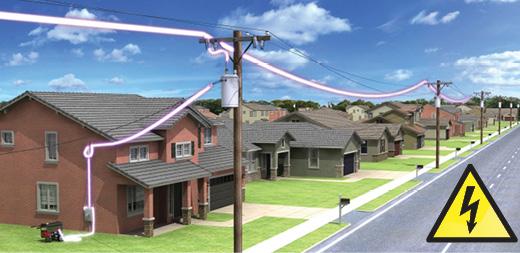

Safely Installing a Standby Generator
When the weather gets rough, a portable generator can be a lifesaver. However, if used improperly, it can prove to be a hazard to you, your home and those working to get your power back on.

Electrocution, fire and carbon monoxide poisoning are all potential consequences of improper generator usage. Play it safe!
Contact West Florida Electric Cooperative (WFEC) for more information on how to ensure your portable generator is an asset, not an endangerment.
When we work together for safety and the good of our communities, we all benefit.
Put Safety First
Never connect a generator directly to your home’s wiring without an appropriate transfer switch installed. This can cause back-feeding along power lines and electrocute anyone coming into contact with them, including line workers making repairs.
Back-feeding is a dangerous condition caused when a portable electric generator is connected to wiring without isolating the power supply. Back feed into power lines from a generator could create “hot” lines during outages. This can be fatal to line workers or others near downed power lines.

A good way to avoid back-feeding is to install a double-pole, doublethrow transfer switch like the GenerLink™ Transfer Switch.
Connecting a generator directly to your home’s wiring can cause back-feeding (see below).
Proper Installation
In accordance with the National Electric Code, paragraph 700-6; transfer equipment shall be designed and installed to prevent the inadvertent interconnect of normal and emergency sources of supply in any operation of the transfer equipment. Automatic transfer switches shall be electronically operated and mechanically held. The transfer switch must be a break-before-make switch which will “break” the electrical connection between your generator and wiring. The switch will also prevent utility power from damaging the generator when regular service is restored. Make sure the transfer switch is rated at the same or greater than the main over current protection. An electrical diagram of an installation using a transfer switch appears in Figure 1.

Since transfer switches can be expensive, another way to install a generator is to have a sub-panel with main breakers and power from the main power or generator. The main panel breaker and generator breaker in the sub-panel should have handles interlocked to prevent both being opened and closed at the same time. This prevents back-feed to commercial power when the generator is in use. See Figure 2.

1. Install breaker and wiring from main panel to feed sub-panel. Note: Wiring and breaker sizes are determined by circuit load needed.
Breaker/Wiring Size Chart:
30 Amp: 10-3 with ground wiring
40 Amp: 8-3 with ground wiring
50 Amp: 6-3 with ground wiring
2. Install sub-panel with properly sized main breakers. Power for one from the main panel and the other from the generator.
3. Install dual supply main breaker/service disconnect retaining kit and
Figure 2handle interlock. Note: Not all manufacturers supply the handle interlock retaining kits for all models of breaker disconnects.
4. Install breakers in sub-panel for circuits desired to be energized from the generator. Note: Smaller generators may not be able to carry the total load for all circuits. Use the load calculation chart (Figure 3) to determine total load. A smaller generator than the total load can be used by turning off some of the breakers when the appliance or lights are not needed. Always use a generator that is at least 25% larger than most necessary loads. This allows for some of the non-essential loads to be used at once.
Figure 3 - APPROXIMATE LOAD CALCULATIONS
Check with your specific equipment & appliance instructions for exact specifications.
Power Up Safely
Never connect a generator directly to your home’s wiring without an appropriate transfer switch, like the GenerLink™.
Operate the generator outdoors in a dry, open space. Never fuel a generator while it is operating.
Use heavy-duty, outdoor-rate extension cords. Ensure generators are properly grounded.
Never overload a generator. Keep generators dry.
Always have a fully charge fire extinguisher nearby. Avoid overloading - turn appliances on one at a time.
Turn off all equipment powered by the generator before shutting it down.
Never plug a generator into an electrical outlet or directly into your home’s wiring.
Read and adhere to all manufacturer’s instructions for safe operation.
Power Up Safely
Always check out the unity thoroughly each new season before you fire it up.
Never attempt to repair an electric generator, only a qualified serviceman should perform repairs.
Don’t remove or tamper with safety devices - they are there to protect you and your property.
Many engine parts are very hot during operation - severe burns may result if touched.
Keep children away from generators at all times.
Always properly disconnect from your utility service before starting your backup generator.
The Dangers of Carbon Monoxide: When using a generator, make sure the exhaust is vented properly - fumes from burnt fuel can be deadly.
Generators & Water: Don’t use generators in flooded areas - it’s a dangerous combination. In addition, make sure hands are dry, you are standing in a dry place, and the generators is properly grounded.
Use Gasoline Safely: Gasoline should only be stored in approved containers, and out of reach of children.
